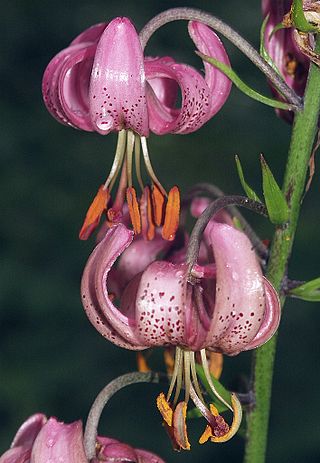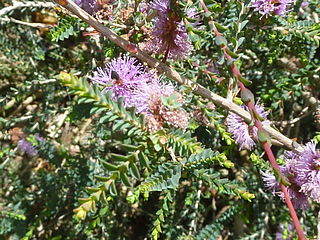
Liliales is an order of monocotyledonous flowering plants in the Angiosperm Phylogeny Group and Angiosperm Phylogeny Web system, within the lilioid monocots. This order of necessity includes the family Liliaceae. The APG III system (2009) places this order in the monocot clade. In APG III, the family Luzuriagaceae is combined with the family Alstroemeriaceae and the family Petermanniaceae is recognized. Both the order Lililiales and the family Liliaceae have had a widely disputed history, with the circumscription varying greatly from one taxonomist to another. Previous members of this order, which at one stage included most monocots with conspicuous tepals and lacking starch in the endosperm are now distributed over three orders, Liliales, Dioscoreales and Asparagales, using predominantly molecular phylogenetics. The newly delimited Liliales is monophyletic, with ten families. Well known plants from the order include Lilium (lily), tulip, the North American wildflower Trillium, and greenbrier.

Alstroemeriaceae is a family of flowering plants, with 254 known species in four genera, almost entirely native to the Americas, from Central America to southern South America. One species of Luzuriaga occurs in New Zealand, and the genus Drymophila is endemic to south-eastern Australia.

Tasmannia lanceolata, commonly known as pepper tree, native pepper, mountain pepper or mountain pepperbush, is a species of flowering plant in the family Winteraceae, and is endemic to south-eastern Australia. It is a dioecious bushy shrub to small tree with lance-shaped or narrowly ellipic leaves, male and female flowers on separate plants, the flowers with 3 to 9 petals, and the fruit a deep maroon to glossy black berry.

Melaleuca armillaris, commonly known as bracelet honey myrtle, is a plant in the myrtle family, Myrtaceae, and is native to South Australia, Victoria and Tasmania in south-eastern Australia. It is a hardy, commonly grown species, often used as a fast-growing screen plant, but it also has the potential to become a weed. It has become naturalised in Western Australia and parts of Victoria. In its natural state, it grows on coastal cliffs and along estuaries.

Dianella tasmanica, commonly known as the Tasman flax-lily or Tasmanian flax-lily is a herbaceous strappy perennial herb of the family Asphodelaceae, subfamily Hemerocallidoideae, found in southeastern Australia including Tasmania. It has leaves to 80 cm, and a flower stem to 1.5 m. Blue flowers in spring and summer are followed by violet berries. It adapts readily to cultivation and is commonly seen in Australian gardens. Unlike other Dianella species, its fruit is toxic.

Goodenia montana, commonly known as mountain velleia, is a flowering plant in the family Goodeniaceae. It is a small, perennial herb with lance-shaped to egg-shaped leaves with the narrower end towards the base, and yellow flowers. It mainly grows in woodland and sub-alpine grasslands in New South Wales, Victoria and Tasmania.

Melaleuca ericifolia, commonly known as swamp paperbark, is a plant in the myrtle family, Myrtaceae and the genus Melaleuca, native to south-eastern Australia. It is a rather variable species and some specimens resemble Melaleuca armillaris but its papery bark and smaller, more prolific flower heads distinguish it from that species. It often grows in swampy areas and the draining and clearing of these has reduced the numbers of the species, especially around Port Philip Bay near Melbourne. It is also similar to Melaleuca pustulata, a Tasmanian endemic, but that species only grows in dry heath.

Drymophila is a genus of flowering plants in the family Alstroemeriaceae. It has also been placed in Luzuriagaceae, Convallariaceae and Liliaceae.

Drymophila moorei, the orange berry, occurs naturally from the Manning River in northern New South Wales to Queensland. The habit is as a herb, occurring at the rainforest floor, usually at high altitudes. Easily identified when in fruit.

Gahnia grandis is a tussock-forming perennial plant found in southeastern mainland Australia and Tasmania.

Micrantheum hexandrum, commonly known as box micrantheum, is a species of flowering plant in the family Picrodendraceae and is endemic to eastern Australia. It is an erect, monoecious shrub with oblong to narrowly lance-shaped leaves, and small white flowers with six or nine stamens. Picrodendraceae.

Pittosporum bicolor, commonly known as cheesewood or banyalla, is a flowering shrub or small tree of the family Pittosporaceae, and is native to south eastern Australia.

Cassytha pubescens is a native Australian hemiparasitic vine species, in the Laurel family. Common names for the species include devils twine, dodder-laurel, spilled devil's twine, snotty gobble or downy dodder-laurel. It is a widespread and common species in south eastern Australia. The species was first formally described in 1810 by the Scottish botanist Robert Brown in Prodromus Flora Novae Hollandiae et Insulae Van Diemen. Leaves are reduced to scales and photosynthesis is achieved through chlorophyll contained in the plants stems. Stems are between 0.5mm and 1.5mm in diameter and the haustoria are between 2 and 3 mm long.

Hibbertia empetrifolia, commonly known as trailing guinea-flower, is a species of flowering plant in the family Dilleniaceae and is endemic to south-eastern Australia. It is a low-lying to spreading shrub with wiry stems, oblong to lance-shaped leaves with the narrower end towards the base, and pale to bright yellow flowers arranged on the ends of branchlets, with five to nine stamens arranged on one side of the two carpels.

Melaleuca gibbosa, commonly known as the slender honey-myrtle or small-leaved honey-myrtle is a plant in the myrtle family, Myrtaceae and is endemic to southern Australia. It is a dense, bushy shrub to about 2 metres (6.6 ft) with numerous slender, arching branches and oblong heads of mauve flower spikes in spring and sparsely throughout the year.

Pimelea glauca, commonly known as smooth riceflower, is a species of flowering plant in the family Thymelaeaceae and is endemic to eastern Australia. It has elliptic to more or less lance-shaped or linear leaves and creamy-white flowers arranged in heads of seven or more on the ends of the stems, with four lance-shaped to egg-shaped bracts at the base of the inflorescence.

Berberidopsis beckleri is a species of climbing plant found in cool rainforests in eastern Australia. Its common name is the montane tape vine. Ferdinand von Mueller described the plant as Streptothamnus beckleri from collections at the Clarence River.

Coprosma moorei, commonly known as blue matcurrant or turquoise coprosma, is a small, mat forming, prostrate shrub in the Rubiaceae family. It is native to highland areas of Tasmania and Eastern Victoria.

Luzuriageae is a tribe of monocotyledonous plants belonging to the family Alstroemeriaceae. It consists of very few species of perennial plants native to South America (Luzuriaga) and Australia and New Zealand (Drymophila). They are climbing plants with more or less woody stems and can be recognised by their distichous leaves which are turned "upside down" at the base, and their polysymmetrical white flowers with plain-coloured tepals and a succulent ovary.


















